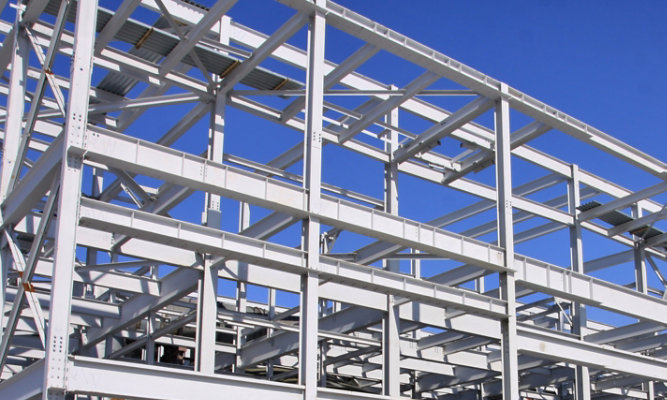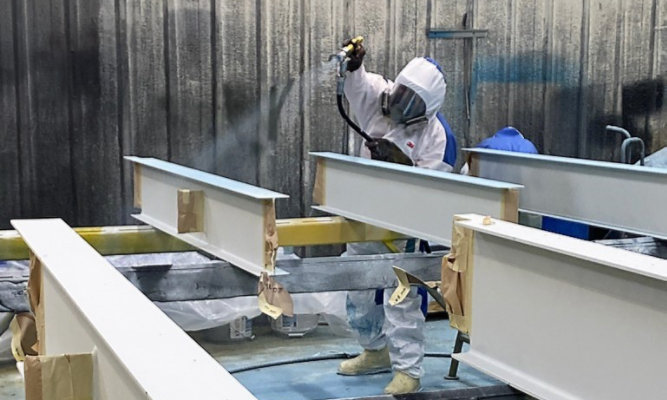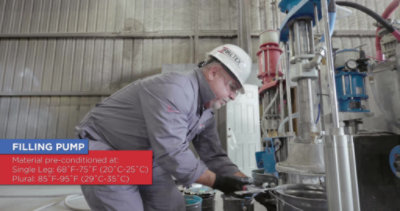Cementitious (SFRM) vs. Intumescent (IFRM) Fireproofing Solutions
by George Guanci, Market Manager – Fire Protection, Sherwin-Williams Protective & Marine
Contact Us for More Information

Steel fireproofing coatings are designed to provide passive fire protection to steel buildings, structures and elements. For decades, cementitious fireproofing was the go-to method for steel fire protection; however, as technology has advanced, more and more architects and engineers are seeing the benefits of intumescent coatings as an effective and successful fire protection option.
There are many differences between these two categories of fireproofing products. Learn the nuances between SFRMs and IFRMs to help design a solution that is best tailored to your construction site.
Cementitious Fireproofing Coatings
Cementitious fireproof coatings, also called sprayed fire-resistant material (SFRM), are usually made of gypsum, vermiculite, or mineral fiber and may contain some Portland Cement. These coatings are applied on structural steel to protect the substrate. After it dries, the SFRM forms a barrier that improves the fire resistance abilities of steel by delaying the rate at which heat is transferred from a fire to the underlying steel.
While the SFRM is an effective fireproofing method for many use cases, these products may also crack, flake or dust as they deteriorate or create an environment where corrosion can occur.
Intumescent Fireproofing Coatings
Intumescent fire-resistant materials (IFRM) are coatings that provide critical passive fire protection on structural steel in commercial and industrial buildings. They are applied directly to the steel and, if exposed to elevated heat levels, char and expand to create a thermal and physical insulative barrier between the high temperature and the underlying steel. The char slows the heating of the substrate, thus reducing the temperature rise of the steel.
During the intumescent process, the intumescent coating can expand approximately 10 to 50 times its original dry film thickness, depending on factors such as the binder type and formulation.
Since IFRM coatings are applied in a thin, aesthetically pleasing layer, they are used throughout the world on exposed steel as well as behind walls and ceilings. These products can also be designed to provide additional benefits such as impact resistance, corrosion resistance and chemical resistance.
Cementitious vs. Intumescent Fireproofing Options: Key Differences
Cementitious and intumescent coatings are both proven methods of fireproofing structural steel, but these two types of fire protection differ in several categories:
Pictured Above and Below: Steel beams coated in intumescent coatings vs. cementitious coatings. Cementitious coatings offer an immediate thick barrier of protection by delaying the rate at which heat is transferred to the structural steel, whereas intumescent coatings have a thinner application but char and expand to protect the steel.
One of the most significant differences between intumescent and cementitious fireproof coatings is the aesthetics of the resulting finish.
Cementitious coatings create a thick barrier on steel that almost looks like cement has been applied to the steel. Alternatively, intumescent coatings provide a smooth, paint-like finish that creates a decorative and aesthetically pleasing final appearance. This feature makes intumescent coatings the ideal choice worldwide for fireproofing exposed steel inin industrial and commercial applications, including airports, arenas, museums, convention centers and hotels. IFRM products also allow for open floor concepts, and clean lines making them the ideal option when aesthetics are a consideration.
Application Method (On-Site vs. Off-Site)
Intumescent coatings are easier, cleaner and quicker to apply than cementitious coatings -- with the added benefit of the option of shop application.
Instead of the fireproofing applicator going to the job site, applying fireproofing products to the steel and then waiting for it to cure, shop-applied intumescent fireproof coatings are, as the name implies, applied in a shop. Then, the steel is shipped to the job site already fireproofed. This off-site process provides additional quality control, a shorter construction cycle, lowers overall costs and results in better aesthetics than coatings applied on-site.
Intumescent coatings are more conducive to shop application; because of the nature of the composite makeup of cementitious coatings, they get damaged much more during transportation to the job site. As shop-applied methods become more and more popular, more intumescent coatings are being used—not only on exposed steel but also behind walls and above ceilings.
Cementitious fireproof coatings are vulnerable to crack, dust and flake over time—which means they are not ideal for clean room environments, laboratory facilities, electronics manufacturing facilities, food products factories or other sites that require the reduction or prevention of contaminants in the air.
The materials used in intumescent fireproofing do not flake, crack or create dust. In response, many pharmaceutical facilities, laboratories and manufacturing environments are including IFRM coatings in their specifications to eliminate the possibility of contaminants.
The chemical makeup of IFRMs provide enhanced corrosion protection over SFRMs, because cementitious fireproof coatings are only well-suited for environments where they are not at risk of exposure to high ambient moisture levels, vibrations or impacts. SFRM coatings absorb moisture, which canlead to the corrosion of the steel. In the long run, corroded steel impacts the integrity of the structure—working in direct opposition to the goals of fireproofing in the first place.
SFRM coatings are designed with cheap materials but require many coats. That means increased labor costs, higher material costs, and more time spent on the project. If, for example, architects wanted to use cementitious coatings in a clean room environment, they would need to not only use the highest grade possible but also apply a topcoat to prevent the dusting and flaking issues that go hand-in-hand with SFRM coatings.
The comparison between cementitious fireproof coatings and intumescent fireproof coatings depends on several factors– but in many cases, due to labor and installation costs, IFRMs come out as the cost-effective option.
If speed is a factor, shop-applied intumescent fireproof coatings is the ideal choice. The application of IFRM coatings is cleaner, quicker, and easier than SFRM coatings, and the intumescent product cures quicker than the cementitious fireproofing—allowing for a more streamlined construction schedule.
Aesthetic differences between smooth intumescent and cementitious fireproofing.
Beams coated offsite are able to be brought in to the construction site, providing more quality control and a shorter construction cycle.
Cementitious coatings are easily cracked and damaged, causing mess and contamination in their environments.
Custom Intumescent Fireproof Coatings for Steel Structures and Buildings
Sherwin-Williams provides fireproof coatings that fully adhere to steel, create a smooth finish, and provide long-lasting fire protection, consider Sherwin-Williams line of FIRETEX® intumescent fire protective coatings. Our cutting-edge products not only meet stringent industry safety standards but also offer additional benefits, including the following:
- Superior resistance to chemicals, wear and tear, impacts, rust, abrasions and corrosion
- Easy application process with quick drying times and off-site options
- Easy-to-clean, low maintenance formulations
- Extremely high adhesion properties
- Attractive, aesthetically pleasing finish
Tailor the intumescent fire protective coating solution that will protect the steel of your facility for years to come.
Get Industry-Leading Intumescent Fire Protection Coating Solutions
At Sherwin-Williams, we are dedicated to protecting steel structures and providing life-saving protection from fires. Our line of proven intumescent fireproof coating systems has been specially designed to deliver superior fire protection that meets the highest industry standards and ensures high temperatures do not damage the integrity of steel structures—all without sacrificing aesthetic appeal. Together, we can design a solution that meets the unique specifications of your facility.
To learn more about our intumescent fire protective coatings, contact a Sherwin-Williams representative today.
ABOUT THE AUTHOR
George Guanci is Market Manager – Fire Protection for Sherwin-Williams Protective & Marine. He has more than 40 years’ experience in the construction industry with the better part of that time serving the fireproofing industry. He has extensive experience in both petrochemical and commercial fireproofing and was among the first to promote intumescent epoxy fireproofing technology in the hydrocarbon processing industry. He is experienced and knowledgeable in UL listings and requirements, international fireproofing standards and the development of fireproofing specifications. Guanci is responsible for market management of the Firetex® commercial fireproofing product line in North America for Sherwin-Williams. He is a member of the Construction Specifications Institute (CSI), AMPP and the National Fire Protection Association (NFPA). He holds a bachelor’s degree from Merrimack College and a master’s degree from Northeastern University. Contact: George.M.Guanci@sherwin.com
Discover More
Industry Expertise and Innovation
See how we help customers find customized solutions for their project and application challenges.
Our Fire Protection Expertise
Explore our industry solutions and technology to help protect your assets.
LEARN MOREProduct Lookup
Find out more about our innovative coatings for a variety of industries.
FIND A PRODUCT

